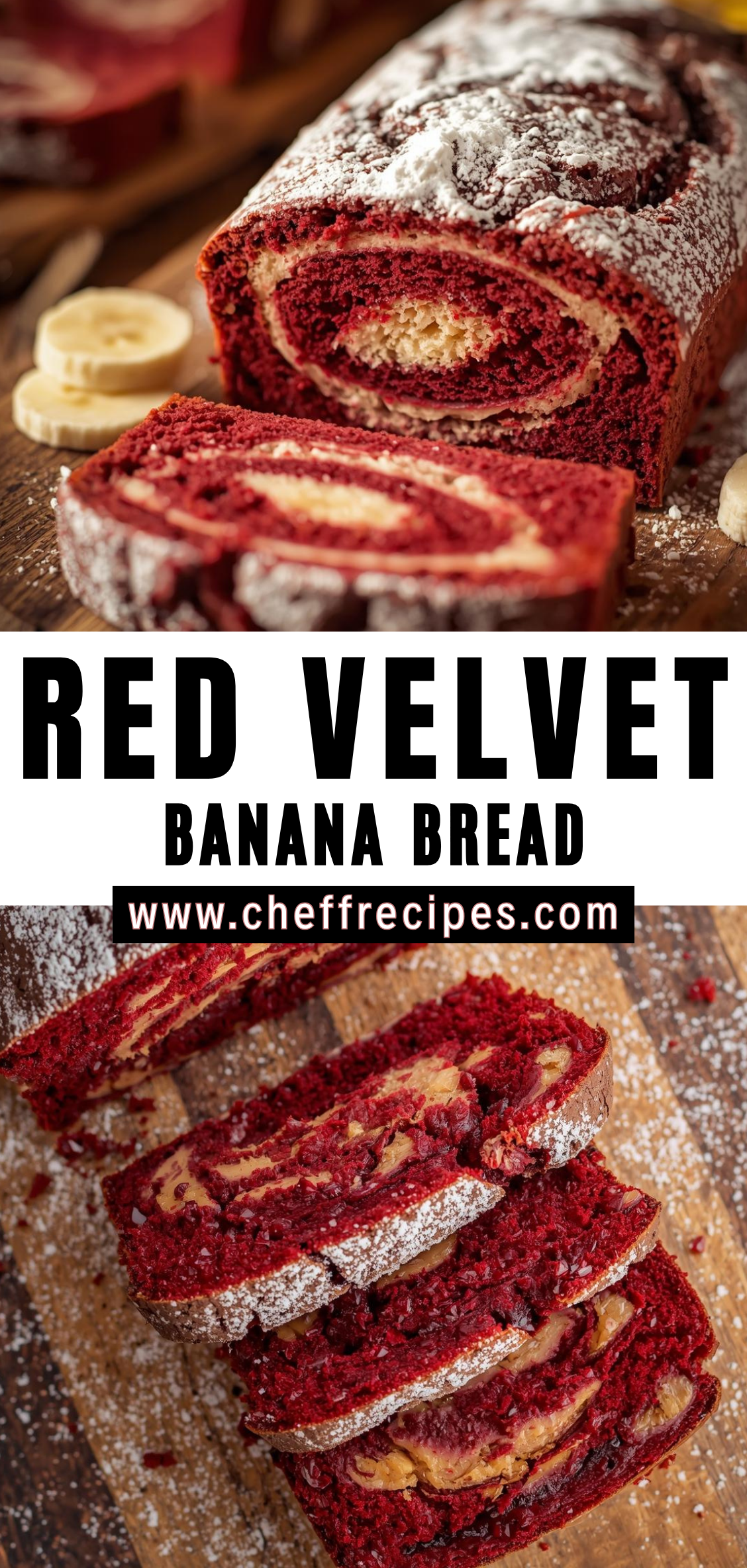Red Velvet Banana Bread is a decadent and uniquely textured twist on two beloved baking traditions: the classic red velvet cake and the timeless banana bread. Both of these baked goods have deep roots in culinary history and cultural significance. Red velvet, with its vibrant hue and mild cocoa flavor, is synonymous with celebration, indulgence, and visual appeal. Banana bread, on the other hand, is celebrated for its comfort, moist crumb, and the clever use of overripe bananas. By combining the two, Red Velvet Banana Bread transforms ordinary ingredients into a visually striking, flavorful, and tender loaf that offers both indulgence and nourishment.

At the heart of this recipe is the concept of layering flavor and texture. Bananas provide natural sweetness, moisture, and a dense yet soft crumb. Their presence ensures that even a loaf rich with cocoa, butter, and sugar remains tender and moist. The red velvet elements—typically including a subtle amount of cocoa powder, buttermilk, and vinegar—introduce complexity: a delicate chocolate undertone, tanginess, and a characteristic deep red hue that sets the loaf apart from traditional banana bread. Understanding how these components interact is key to mastering the recipe.
Color and presentation are central to the Red Velvet Banana Bread experience. The red hue, historically achieved through reaction between cocoa and acidic ingredients such as buttermilk or vinegar, has become a signature feature of red velvet baked goods. In this banana bread adaptation, careful attention to ingredient ratios ensures that the red color remains vibrant without compromising flavor or texture. This visual element is not superficial; it signals flavor balance, baking precision, and attention to detail.
Texture in Red Velvet Banana Bread is equally crucial. Overripe bananas contribute moisture and natural sweetness, but they also increase the loaf’s density. This must be balanced with ingredients that lighten the structure, such as eggs, leavening agents, and aeration techniques during mixing. The subtle cocoa in the batter adds body without heaviness, while butter or oil contributes richness. The interplay of these elements produces a loaf that is tender, moist, and slightly springy—a texture that distinguishes Red Velvet Banana Bread from either traditional banana bread or a standard red velvet cake.
The flavor profile of Red Velvet Banana Bread is both layered and harmonious. Bananas provide natural sweetness and fruitiness. Cocoa adds mild chocolate undertones. Buttermilk contributes tang and tenderness, while a touch of vanilla or almond extract enhances aromatic complexity. Sugar balances acidity and deepens browning, while optional inclusions such as cream cheese swirls, chocolate chips, or nuts create bursts of texture and flavor that make each bite interesting. Understanding these flavor dynamics is essential for executing the recipe successfully.
Baking Red Velvet Banana Bread is as much a science as an art. The order of ingredient incorporation, mixing methods, and baking temperature all influence the final loaf. Overmixing can lead to a tough or dense crumb; under-mixing may result in uneven distribution of banana or cocoa. The interaction between leavening agents and acidic ingredients must be precise to achieve rise, tenderness, and proper crumb structure. Mastery of these technical aspects allows the baker to produce a loaf that is consistent, visually appealing, and flavorful.
Culturally, this recipe embodies the idea of hybrid baking—a blending of traditional techniques and contemporary creativity. It honors the familiarity of banana bread while incorporating the celebratory nature of red velvet. This combination makes it suitable for everyday enjoyment, gifting, or special occasions. The loaf is versatile, whether sliced for breakfast, served as a dessert, or shared at gatherings. Understanding its context enhances appreciation and guides presentation choices.
Finally, the sensory experience of Red Velvet Banana Bread is multi-dimensional. The aroma of ripe bananas, cocoa, and baked sugar fills the kitchen during baking. The sight of a vibrant red crumb, possibly marbled with cream cheese, invites anticipation. The texture—soft, moist, and tender, with optional crunchy or creamy additions—delivers satisfaction with every bite. Flavor is harmonious, blending fruitiness, cocoa, and subtle tang, with sweetness balanced but never cloying. Appreciating these sensory elements provides motivation to follow the detailed instructions carefully, as small variations in ingredient quality or technique can affect the final loaf.
Red Velvet Banana Bread – Detailed Instructions
1. Ingredient Selection and Preparation
Bananas
-
Use ripe or overripe bananas with brown spots.
-
Ripe bananas are sweeter and softer, contributing natural sweetness, moisture, and flavor.
-
Peel and mash them thoroughly using a fork or potato masher until smooth but with slight texture if desired.
-
Measure after mashing; typically 1 to 1¼ cups of mashed banana are needed for a standard loaf.
Flour
-
Use all-purpose flour for a tender yet structured crumb.
-
Sift the flour with cocoa powder, baking soda, and salt to ensure even distribution and aeration.
-
Avoid over-packing flour when measuring, as this can create a dense loaf. Spoon into the measuring cup and level with a straight edge.
Cocoa Powder
-
Choose a high-quality unsweetened cocoa powder.
-
Cocoa provides subtle chocolate flavor and contributes to the red velvet characteristic when combined with acidic ingredients.
-
Measure precisely and sift with the flour to avoid clumping.
Sugar
-
Granulated sugar is traditional, but a mixture of granulated and brown sugar adds moisture and depth.
-
Brown sugar contributes a mild caramel flavor that complements bananas.
Fat
-
Butter or vegetable oil can be used.
-
Butter adds richness and flavor, while oil contributes to moisture retention.
-
If using butter, ensure it is softened at room temperature for easy creaming.
Eggs
-
Large eggs bind ingredients and add structure.
-
Bring eggs to room temperature to prevent curdling when mixed with wet ingredients.
Buttermilk or Yogurt
-
Acidic liquid (buttermilk or yogurt) reacts with baking soda to create lift and tender crumb.
-
Measure precisely and stir gently to avoid over-activating the leavening too early.
Vanilla Extract
-
Adds aromatic depth and enhances banana flavor.
-
Use pure extract for the best flavor.
Optional Ingredients
-
Cream cheese for swirls, chocolate chips, or chopped nuts add flavor contrast and texture.
-
If adding, fold in gently after primary mixing to avoid deflating the batter.
2. Preparing the Pan
-
Select a loaf pan, typically 9×5 inches.
-
Grease thoroughly with butter or nonstick spray.
-
Optionally, line with parchment paper for easy removal of the loaf.
-
Lightly flour the pan or dust with cocoa powder to prevent sticking while maintaining the integrity of the red velvet color.
3. Preheating the Oven
-
Preheat to 350°F (175°C) for conventional ovens.
-
Ensure the oven reaches temperature before baking; premature insertion can affect rise and texture.
-
Position the rack in the center of the oven for even baking.
4. Mixing Wet Ingredients
-
In a medium bowl, cream softened butter with sugar until pale and fluffy.
-
This incorporates air for a lighter crumb.
-
If using oil instead of butter, mix with sugar until combined; oil cannot trap air like butter, so the batter may be denser.
-
-
Add eggs one at a time, beating lightly after each addition.
-
Ensures smooth incorporation and prevents curdling.
-
-
Mix in vanilla extract and mashed bananas until fully combined.
-
Bananas should be fully integrated but avoid overmixing to preserve batter aeration.
-
-
Stir in buttermilk or yogurt gradually to create a smooth, cohesive batter.
5. Mixing Dry Ingredients
-
In a separate bowl, sift together flour, cocoa powder, baking soda, and salt.
-
Sifting removes lumps and ensures even distribution of leavening agents.
-
Baking soda reacts with acid in buttermilk to produce rise.
-
-
Optional: fold in optional additions (nuts, chocolate chips) into dry mix for even distribution.
6. Combining Wet and Dry Ingredients
-
Add dry ingredients to wet ingredients gradually.
-
Fold gently using a spatula or wooden spoon until just combined.
-
Overmixing activates gluten, which can create a tough or dense loaf.
-
-
Check batter consistency: it should be thick but pourable.
-
If using cream cheese swirls, gently fold in after combining or layer in the pan before baking.
7. Coloring and Red Velvet Effect
-
Traditionally, red food coloring is added to enhance the red hue.
-
Add 1–2 teaspoons of gel or liquid red food coloring to the batter and fold gently.
-
Ensure even distribution without overmixing.
-
Note: natural reddish hue from cocoa and vinegar will be subtle; food coloring intensifies visual appeal.
8. Transferring Batter to Pan
-
Pour batter into prepared loaf pan.
-
Use a spatula to level the surface for even baking.
-
Optional: create a slight swirl pattern with cream cheese if included.
-
Lightly tap the pan on the counter to remove air pockets.
9. Baking the Loaf
-
Positioning the Pan
-
Place the loaf pan in the center of the oven for even heat circulation.
-
Avoid placing too close to the top or bottom elements; uneven heat can cause overbrowning or undercooked centers.
-
-
Baking Time
-
Bake at 350°F (175°C) for 50–65 minutes, depending on oven calibration and loaf size.
-
Start checking at 50 minutes to prevent overbaking.
-
Smaller loaves or mini-loaf pans may require 35–45 minutes; larger or deep pans may take 65–75 minutes.
-
-
Browning and Aroma
-
The top should turn deep golden brown with a slightly firm crust.
-
A subtle crack along the center is normal and indicates proper rise.
-
The aroma of bananas, cocoa, and baked sugar signals near readiness.
-
10. Testing Doneness
-
Toothpick Method
-
Insert a clean toothpick or cake tester into the center of the loaf.
-
If it comes out clean or with a few moist crumbs, the bread is done.
-
Wet batter indicates underbaking; continue baking in 5-minute increments.
-
-
Finger Test
-
Gently press the top center of the loaf.
-
It should spring back slightly; if it sinks, it needs more baking.
-
-
Internal Temperature
-
For precise results, use a thermometer: the internal temperature should reach 200–205°F (93–96°C) for fully baked quick breads.
-
11. Cooling the Loaf
-
Initial Cooling
-
Remove the pan from the oven and place it on a wire rack.
-
Let it cool 10–15 minutes in the pan. This prevents the loaf from breaking when removed.
-
-
Removing from Pan
-
Carefully run a butter knife along the edges to loosen.
-
Invert the loaf onto a wire rack or use parchment overhang if lined.
-
-
Complete Cooling
-
Allow the bread to cool completely (about 1–2 hours) before slicing.
-
Cooling ensures the crumb sets and prevents gummy texture.
-
12. Slicing and Serving
-
Slicing Technique
-
Use a serrated knife for clean cuts without crushing the crumb.
-
Cut even slices, about ½–¾ inch thick, depending on preference.
-
-
Serving Suggestions
-
Serve as is for breakfast, snack, or dessert.
-
Optional toppings: a dusting of powdered sugar, cream cheese frosting, or a drizzle of chocolate glaze.
-
Can be paired with coffee, tea, or milk to enhance the eating experience.
-
Red Velvet Banana Bread
Red Velvet Banana Bread is a decadent and uniquely textured twist on two beloved baking traditions: the classic red velvet cake and the timeless banana bread. Both of these baked goods have deep roots in culinary history and cultural significance. Red velvet, with its vibrant hue and mild cocoa flavor, is synonymous with celebration, indulgence, and visual appeal. Banana bread, on the other hand, is celebrated for its comfort, moist crumb, and the clever use of overripe bananas. By combining the two, Red Velvet Banana Bread transforms ordinary ingredients into a visually striking, flavorful, and tender loaf that offers both indulgence and nourishment.
Ingredients
- Wet Ingredients:
- 1 cup mashed ripe bananas (2–3 medium bananas)
- ½ cup vegetable oil or melted butter
- ½ cup sugar (or ¼ cup brown sugar + ¼ cup granulated sugar)
- 2 large eggs
- 1 teaspoon vanilla extract
- 1–2 teaspoons red food coloring (adjust for desired red color)
- Dry Ingredients:
- 1 ½ cups all-purpose flour
- 2 tablespoons cocoa powder
- 1 teaspoon baking soda
- ½ teaspoon baking powder
- ¼ teaspoon salt
- Optional Add-ins:
- ½ cup white or dark chocolate chips
- ½ cup chopped walnuts or pecans
- Cream cheese swirl (optional): 4 oz cream cheese + 1 tablespoon sugar + ½ teaspoon vanilla
Instructions
1. Preheat Oven
- Preheat oven to 350°F (175°C).
- Grease a 9×5-inch loaf pan or line with parchment paper.
2. Mix Wet Ingredients
- In a large bowl, mash bananas until smooth.
- Stir in oil (or melted butter), sugar, eggs, vanilla, and red food coloring until well combined.
3. Mix Dry Ingredients
- In a separate bowl, whisk together flour, cocoa powder, baking soda, baking powder, and salt.
4. Combine Wet & Dry
- Gradually fold the dry ingredients into the wet ingredients until just combined.
- Do not overmix—the bread will be dense but moist.
- Fold in chocolate chips or nuts if using.
5. Optional Cream Cheese Swirl
- Beat cream cheese, sugar, and vanilla until smooth.
- Drop spoonfuls on top of batter and swirl gently with a knife.
6. Bake
- Pour batter into the prepared loaf pan.
- Bake 50–60 minutes, or until a toothpick inserted in the center comes out clean.
- If the top browns too quickly, tent with foil during the last 10–15 minutes.
7. Cool & Serve
- Cool in the pan 10 minutes, then transfer to a wire rack to cool completely.
- Slice and enjoy plain or with a smear of butter or cream cheese frosting.
Notes
- Bananas: Use overripe bananas for maximum sweetness and moisture.
- Red Color: Adjust food coloring to your preference; gel-based colors give a more vibrant red.
- Variations: Add a teaspoon of instant espresso powder to enhance the cocoa flavor. Swap half the flour for whole wheat flour for a nuttier texture.



